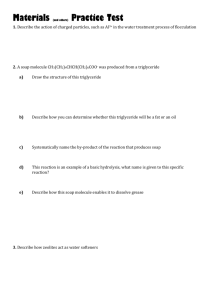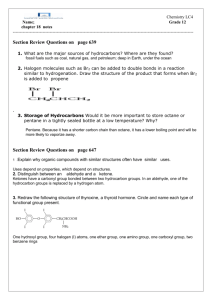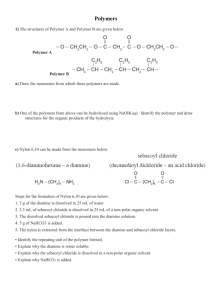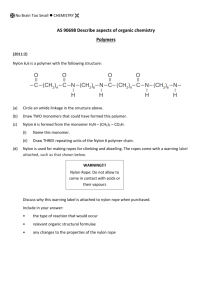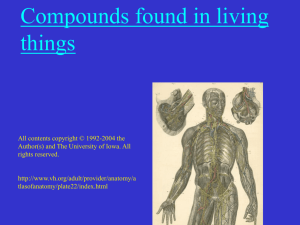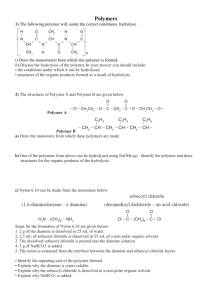Polymer questions - No Brain Too Small
advertisement
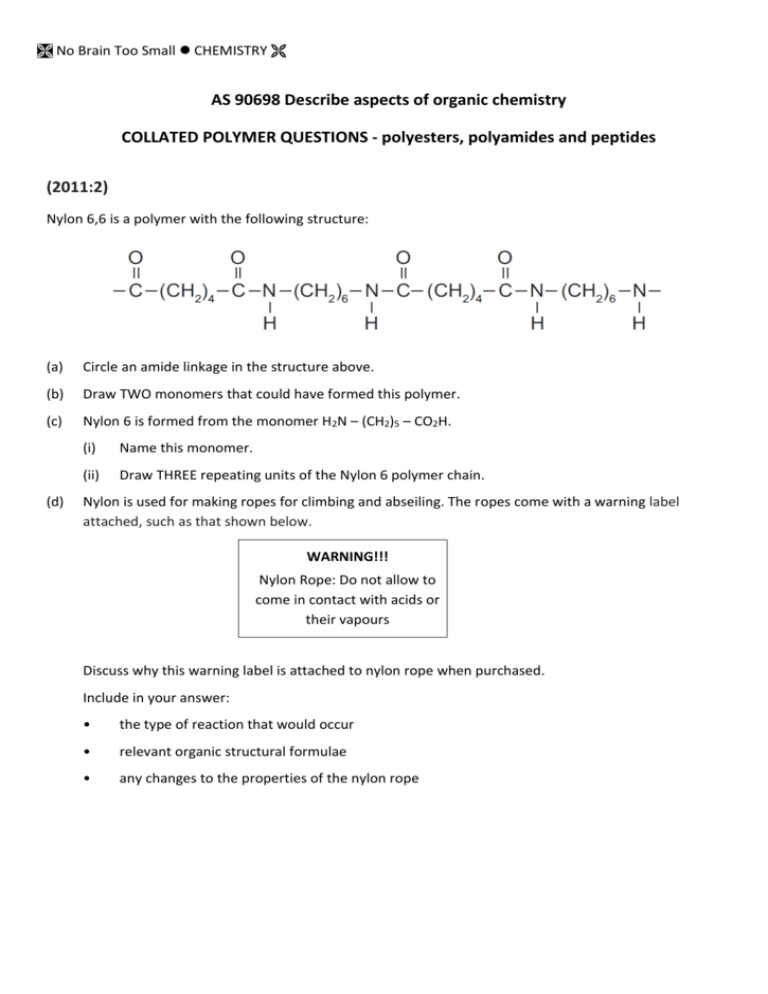
No Brain Too Small CHEMISTRY AS 90698 Describe aspects of organic chemistry COLLATED POLYMER QUESTIONS - polyesters, polyamides and peptides (2011:2) Nylon 6,6 is a polymer with the following structure: (a) Circle an amide linkage in the structure above. (b) Draw TWO monomers that could have formed this polymer. (c) Nylon 6 is formed from the monomer H2N – (CH2)5 – CO2H. (d) (i) Name this monomer. (ii) Draw THREE repeating units of the Nylon 6 polymer chain. Nylon is used for making ropes for climbing and abseiling. The ropes come with a warning label attached, such as that shown below. WARNING!!! Nylon Rope: Do not allow to come in contact with acids or their vapours Discuss why this warning label is attached to nylon rope when purchased. Include in your answer: • the type of reaction that would occur • relevant organic structural formulae • any changes to the properties of the nylon rope No Brain Too Small CHEMISTRY 2010 (3) The polymer commonly known as Kevlar is used to make bullet-proof vests and bicycle tyres. It can be made in a condensation reaction from either of the following pairs of monomers: However, the second pair of monomers needs to be heated for the polymerisation reaction to take place. Note: is a benzene ring and should be treated as a hydrocarbon chain. It is not a functional group and does not change during the reaction. Discuss these polymerisation reactions. Your answer should include: a repeating unit of the polymer chain reasons for the choice of monomers identification of the functional group in the polymer a reason why this is classified as a condensation reaction a comparison of the two pairs of monomers, including the reason that the second reaction will not take place without heating. 2009 (3) (a) Kodel is a polymer with the following structure: (i) Identify TWO monomers for this structure. (ii) Explain why this type of polymer is known as a condensation polymer. (b) Compound X is a polymer which can be hydrolysed to give a single monomer, Compound Y, which has the molecular formula C3H6O3. Compound Y will turn blue litmus red, and can exist as enantiomers (optical isomers). It will react with acidified potassium dichromate to form Compound Z, which has the molecular formula C 3H4O3. Compound Z does not react with Tollens’ reagent. (i) (ii) Draw the structures of Compounds Y and Z. Draw a section of the polymer, Compound X, showing at least two repeating units. No Brain Too Small CHEMISTRY 2008 (2) Amino acids are the building blocks that make up proteins. Alanine and valine are amino acids which can combine to form dipeptides. H H H H C C H N O H C H O H H H H C H H C C C H H N H alanine O C H O H valine Draw the structure of a possible dipeptide formed from the combination of alanine and valine. 2007 (2) (c) Lactic acid is able to form a condensation polymer in the presence of dilute sulfuric acid. Draw three repeating units of this polymer. H O H H O H C C C H O H Monomer: 2006 (2) (part) O Draw a single repeating unit for the nylon polymer formed. O H No Brain Too Small CHEMISTRY 2005 (3) (b) Polyesters are polymers that can be made from two different monomers or from a single monomer. Discuss this statement, using the structures of specific monomers and the polyesters that can be made from them, to illustrate your answer. Your answer should demonstrate a clear understanding of the highlighted terms. 2004 (1) (e) undergoes a condensation reaction with the following molecule (commonly referred to as alanine). It forms two different organic products referred to as dipeptides. (i) (ii) Draw the structural formulae for the two possible dipeptides. Explain why the formation of dipeptides is referred to as a ‘condensation reaction’. No Brain Too Small CHEMISTRY Answers 2011 (2) (a) (b) One link is circled. One set of monomers (can be in any order) (c) (i) 6-amino hexanoic acid (ii) (d) The acid would hydrolyse the rope. This would cause the amide linkages to break and form the monomers. The rope would lose strength. OR products from nylon 6,6. 2010 (3) The repeating group is: The monomers have functional groups at both ends, so can react to form a long chain. (mention of diacid chloride, diacid, diamine sufficent). The acid chloride and amine react to give an amide functional group or peptide bond. The reaction is a condensation reaction, since a small molecule (HCl or H2O) is released. When the amine and the acid are used without heating, a proton transfer (acid-base reaction) occurs and hence polymerisation does not occur until the reaction is heated. The acid chloride is more reactive than the carboxylic acid. No Brain Too Small CHEMISTRY Additional explanation Cl O C C O H Cl N N H H diacyl chloride H diamine No heat is needed since the –COCl group is so much more reactive than the –COOH group. O C N H Cl H C N O H amide/peptide link This is of course just a small section of the polymer as further units would react in an ABABABA fashion…… O C N H Cl H C H N N H N H O H O O C O H H C O H H N N H H H will give the same polymer but this reaction needs heat otherwise will just be an acid-base reaction between –COOH (acid) and –NH2 (base) functional groups. No Brain Too Small CHEMISTRY 2009 (3) (a) (i) H O H H C C H H O H and H Cl O either (ii) O O C H O C C O Cl C O OR A small molecule, such as H2O or HCl, is eliminated when the monomers join. No Brain Too Small CHEMISTRY Additional explanation Find the repeating units – and where the monomers joined to make the polymer – the ester link is the key to this question. “Break up” the structure where it would have formed in an esterification reaction. And remember there are 2 ways to make an ester: R-COOH + HO-R or R-COCl + HO-R So put the 2 x -OH back onto the C=O to give 2 x –COOH carboxylic acid groups… So put the 2 x -H back onto the -O and O- to give 2 x –OH alcohol groups… So put the H’s back onto the -O and O- to give 2 x –OH alcohol groups… OR 2 x –Cl back onto the C=O to give 2 x –COCl acyl (acid) chloride groups ester link So put the 2 x -OH back onto the C=O to give 2 x –COOH carboxylic acid groups… OR 2 x –Cl back onto the C=O to give 2 x –COCl acyl (acid) chloride groups (b) (i) Compound Y has the molecular formula C3H6O3. Compound Y will turn blue litmus red – it must be an acid with a –COOH group Can exist as enantiomers (optical isomers) – it must have a chiral / asymmetric carbon atom It will react with acidified potassium dichromate to form Compound Z with a molecular formula C3H4O3 – it must have a 1o or 2o alcohol group or an aldehyde group to be able to be oxidised by the acidified potassium dichromate; the only one that could give you the chiral C is if it is a 2o alcohol. Compound Z, C3H4O3, does not react with Tollens’ reagent – It must still have the –COOH group and since it is NOT an aldehyde, it must have a ketone group and so Y must have had a 2 o alcohol group. Y: Z: H H H C C H O H O H C O H C C O H H C O H O No Brain Too Small CHEMISTRY (iii) Section of the polymer, Compound X, showing at least two repeating units. Z has –OH and –COOH on the same molecule so could form a polymer with an ester link H H H C C H O C H O O O C H C C H H O H H O H H can be redrawn as O H H O H C C H C H O H H O O H H C C H to give C H O H H O O H H C C H C H O H ( + water molecules) 2008 (2) Amino acids are the building blocks that make up proteins. Alanine and valine are amino acids which can combine to form dipeptides. or Additional explanation Redraw each monomer so H2N-X-COOH and H2N-Y-COOH then lose a molecule of water from –OH of –COOH on one molecule and –H of H2N- of other, forming an amide link. NOTE: Because the two amino acids were different you can form 2 different dipeptides; 2! (2x1). No Brain Too Small CHEMISTRY They are different because has valine as the N-terminus (NH2 end) and alanine as the C-terminus, while the C-terminus. has alanine as the N-terminus and valine as (If there were 3 different amino acids you could form 6 different tripeptides - 3! (3x2x1). 2007(2) (c) (needs 3 units and correct “ends”) Additional explanation H H H O C C H H H H O C H O C H H C C H H O H O O H C O C H O H C O H H 2006 (2) Repeating unit is an amide linkage, ie –HN(CH2)6NHOC(CH2)4CO– (dimer acceptable) Or H H H N H C H H H C H C H C H H H H C H N C H C H O C H H C H H C H H H C O C H O No Brain Too Small CHEMISTRY 2005(3) • • A polymer is a long chain molecule formed when many molecules or units (ie monomers) link together. Polyester chains are formed by condensation with the loss of H2O or HCl at each ester linkage. • • Polyesters contain ester linkages. A single monomer must be a hydroxyl alkanoic acid or hydroxy alkanoyl chloride eg HO(CH2)4COOH / HO-R-COOH (could just say must have an alcohol and a carboxylic acid / acyl chloride functional group on it). Two different monomers can be a diol and a dioic acid / a diol and a dioyl chloride • HOOC(CH2)nCOOH + HO(CH2)mOH ClOC(CH2)nCOCl + HO(CH2)mOH Or two different hydroxy alkanoic acids / two different hydroxy alkanoyl chlorides eg HOOC(CH2)nOH + HOOC(CH2)mOH ClOC(CH2)nOH + ClOC(CH2)mOH 2004 (1) (e) (i) (ii) Condensation reaction results in removal of a small molecule OR water during the bonding reaction between the 2 molecules, in this case a water molecule is produced for every peptide bond formed. The OH is removed from the carboxylic acid group/end and the H is removed from the amine group/end.

